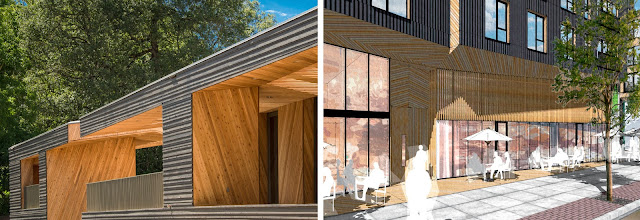 |
| LEFT: Photography of Sokol Blosser winery by Allied Works Architecture (completed July 2013). RIGHT: Rendering by Anonymous Firm A (published November 2014) |
The two projects shown above are for different clients, have different programs and are of vastly different scales. However, I can't help but see the concepts, carving out a dark gray box to reveal naturally colored. angled wood to be intricately related. The project on the left was completed in 2013, received an AIA Portland Honor Award last year, and has been praised for it's beautiful execution throughout the Portland design community. It is a building that most architects in the city know about and have probably visited. The image on the right is a rendering for a proposed development in NW Portland, published on a blog in Nov. 2014.
Can you copyright the design of a building? According to this
article on ArchDaily.com, yes you can (
http://www.archdaily.com/328870/the-10-things-you-must-know-about-architectural-copyrights/). Recently there have been some relatively high profile news stories about architecture being copied. It happened to a Zaha Hadid project in
China, and also a high rise project in
Miami. Over the past few days I've surprisingly come across a series of designs that make me think something similar is happening in Portland, Oregon. The images below compare projects in Portland that have been designed by some of the leading firms in town on the left, juxtaposed on the right by renderings of proposed projects all by the same firm.*
*I have decided to leave their name off this post so as not to draw attention to the specific actions of this one firm, but rather have this be a conversation about the larger theme of design ethics and architectural copyright. For the captions I have replaced the firm's name with Anonymous Firm A.
 |
| LEFT + CENTER: Photography of The Tower House by Ben Waechter (completed October 2013). RIGHT: Rendering by Anonymous Firm A (taken from their website in Nov. 2014) |
Architects, often look to other prominent work for inspiration. Part of the design process is doing precedent studies, looking at how creative people solved design challenges in the past, and how they might be relevant to a current situation. I can understand looking to one of the most respected design firms in town to inform your own design decision. However, there is a fine line between inspiration and copying and there is an ethical line that should not be crossed.
You could give the benefit of the doubt to a firm if one of their designs resembles that of another project. It happens. No one designs in a vacuum and often many people could distill down their ideas into similar results. However, when a single act becomes a pattern, benefit of the doubt fades into disrespect.
 |
| LEFT + CENTER: Photography of The Skyline Residence by Skylab Architecture (completed 2011). RIGHT: Rendering by Anonymous Firm A (taken from their website in Nov. 2014) |
My question is why a firm would risk their reputation emulating other people's work so closely, and more importantly who is commissioning them to do so? Shouldn't a client want a unique project that specifically responds to their needs and the context of their building? Shouldn't the Code of Ethics that comes with Architectural Licensure and AIA membership hold people accountable for the quality of their own designs and respecting the work of others? Finally, if you are going to closely replicate the styles of other architects, why do it in your own backyard where the design community can easily identify what is happening?
 |
| LEFT: Rendering of The Radiator by Path Architecture (Under Construction 2014). RIGHT: Rendering by Anonymous Firm A (published November 2014). |
Copying can be thought of as a form of flattery. It can also reveal a lack of creativity. When repeated over and over by the same firm, I tend to lean towards the latter. What do you think? Do you have other examples of copyright infringement in Architecture? What should our profession do to combat this issue? Should the AIA enforce ethical design issues like this, perhaps revoking membership? Should our state licensure boards?










